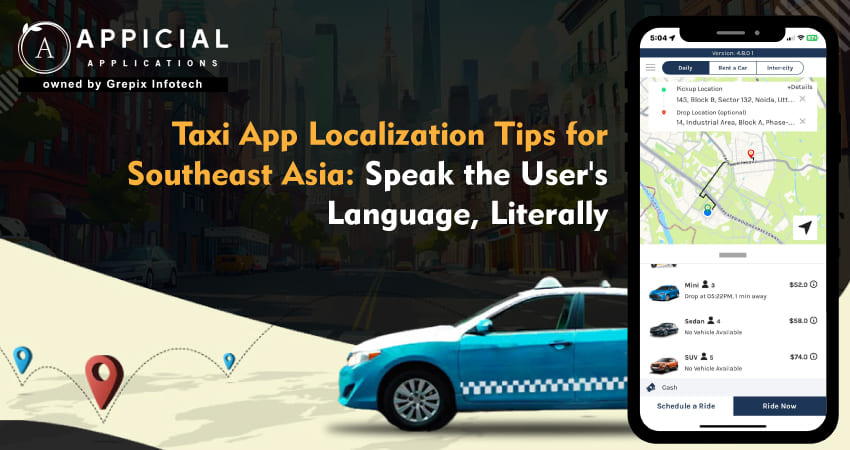
Taxi App Localization Tips for Southeast Asia: Speak the User's Language, Literally
Imagine opening a taxi app, only to see the prices in a foreign currency, directions in a language you don’t understand, and payment options you’ve never heard of.
Annoying, right?
That’s the daily frustration faced by many users in Southeast Asia when using apps that weren’t built with them in mind.
Southeast Asia isn’t a monolith, it’s a vibrant patchwork of languages, currencies, cultures, and consumer habits. From bustling Bangkok to scenic Saigon, user expectations vary dramatically. A one-size-fits-all app simply won’t cut it.
That’s why localization isn’t just a nice-to-have feature, it’s an absolute necessity.
This blog unpacks practical, high-impact localization strategies specifically for taxi and ride-hailing apps targeting Southeast Asia. We’ll explore the must-have languages, currencies, and payment methods, along with actionable tips on local marketing and essential tools to guide your journey.
If you want your app to thrive in SEA’s dynamic markets, start by making it truly local.
Southeast Asia's diversity makes taxi app localization essential, not optional. From languages like Thai and Tagalog to currencies like Rupiah and Baht, localizing your ride-hailing app ensures smoother user experiences. This blog dives into the vital steps: adapting UI to regional preferences, offering native payment options like GCash and TrueMoney, and executing local marketing through influencers and promotions. Tools like Phrase, Mapbox, and Mixpanel can guide your localization journey. With real-world examples like Gojek and Grab, this blog helps you build an app that feels truly local and wins across Southeast Asia’s dynamic markets.
Taxi App Localization Tips for Southeast Asia
You are opening an app and having prices listed in the incorrect currency, or a map that doesn't highlight local landmarks.
Now imagine trying to order a ride in your own city, only to have the driver not speak your language. Frustrating, isn't it?
That's precisely what a lot of Southeast Asian users encounter when a taxi app is not designed with their regional requirements.
This is where the taxi app localization steps in to save the day.
It's not merely a matter of translating, it's about making your app conform to local culture, payment tendencies, and driving habits.
Southeast Asia is highly heterogeneous. What succeeds in Singapore may not work in Vietnam. An attribute embraced in Bangkok may bewilder users in Manila. If localization is not done, even the most intelligent app may come across as cumbersome.
So, how do you build a regional taxi app that communicates with individuals in every nook and cranny of this region? Let's explore the nitty-gritty advice that makes your app local and ultimately successful.
What is App Localization?
App localization is an easy process of tailoring an app so that it can accommodate the language and culture of a certain region's users. Translating texts is not the only thing that is done, but the process also includes changing currency, time format, images, colors, and even functionality. This allows the app to come across as natural to native users.
For instance, if an American-made ride-hailing application is used in Thailand, and if the prices are displayed in dollars only and maps in English only, the local users will be lost. But if the application displays prices in Thai Baht, has Thai language usage, and displays regional landmarks, it is comfortable and convenient to use.
This is where localization comes in handy. It makes users feel as if the app was developed specifically for them. A well-localized multi-language app can run smoothly across a lot of countries, providing each user with a native-like experience.
Why App Localization Matters in Ride-Hailing?
Users typically prefer to order a ride as soon as possible and conveniently. If the app is complicated or does not translate or adapt to their language or behaviour, they will abandon it. This is where taxi app localization comes in.
Each country in Southeast Asia is unique. They have different languages, spend different money, and travel differently. Some travel more on motorbikes than cars. Some pay in cash, others use wallets. A taxi app in the region has to accommodate these. Otherwise, users will feel lost or excluded.
With taxi app localization, your app communicates the user's language, displays local fares, and employs familiar maps. It makes the users feel secure and in charge. Moreover, a multi-language app provides individuals with more options. It enables them to select their preferred language. This makes it simpler for more individuals to use the app.
So, when your app is local, people use it more. If you intend to expand into new locations, particularly in Southeast Asia, localization is not additional; it's essential.
What Language & Currency Options Do You Need to Include for Southeast Asia?
If you're planning to create a regional taxi app for Southeast Asia, choosing the right language and currency options is absolutely vital. This is a multi-cultural and multi-lingual region, and your app must be native-like for its users to trust it.
Let's discuss language first. Users want apps in their native language. Thus, your app should be able to handle:
- Thai for Thailand
- Bahasa Indonesia for Indonesia
- Vietnamese for Vietnam
- Tagalog for the Philippines
- Burmese for Myanmar
Including these languages will enable more users to use your app with convenience and ease. That is why having a multi-language app is the way to go for this market.
Second comes currency. Nobody likes to estimate the fare of a trip. Use local currencies:
- IDR (Indonesian Rupiah)
- THB (Thai Baht)
- VND (Vietnamese Dong)
- PHP (Philippine Peso)
- MMK (Myanmar Kyat)
How to Do Local Marketing for Your Taxi App?
You may have built a great application. But if the people themselves do not know about it, they will not be using it. That's why local marketing is really significant, particularly when you are looking to let your regional taxi app expand.
The following are some easy ways to promote your app in the best possible way.
1 Use Local Languages in Ads
You should use words and phrases that locals understand and relate to. For example, a ride-hailing app in Thailand should use Thai slang and references people see every day. This makes the message feel authentic and friendly. A multi-language app should ensure each iteration of your app translates well to the country's language and tone in which it is situated. If the people perceive the app as speaking their language, then they will engage more with it.
2 Work with Local Influencers
Influencers have massive followings on social media sites since they have already gained the trust of the people. When you partner with local influencers, particularly on Instagram, you are exposing your app to thousands of individuals. Furthermore, when they recommend your app, it is a word-of-mouth that is trusted.They can also highlight the user-friendliness, local payment methods, and language translation, all of which are involved in your taxi app localization process.
3 Provide Local Promotions
No one dislikes a good offer! Providing discounts during local festivals or events will attract attention to your app. For instance, in Vietnam, providing discounts on Tet (Lunar New Year) will make your app more local and culturally friendly. As in Manila, you may provide a "rainy day" promotion during monsoon season. Local promotions give your regional taxi app the sense that it's in sync with what users care about. With promotions that reflect their daily routine and holidays, users will be more inclined to open your app when they are in need of a ride.
4 Local Payment Options
Ensure your app is inclusive of local payment options that individuals are already accustomed to. In the Philippines, users tend to pay for services using GCash. In Thailand, TrueMoney is widely used. Providing local payment methods can give your app the impression that it was developed with the local market in mind.
For promotions, you can even include cashback offers via these local wallets. Users are likely to use your local taxi app if they don't have to go through international payment systems with which they are not familiar or do not trust.
5 Participate in Local Social Media Groups
You should participate in Reddit forums, Facebook groups, or more, where people are discussing about transportation, local news, cultural things, or daily life.
Interact by responding to questions about your app, providing ride-booking advice, or giving helpful tips. This creates a personal relationship with users and lets them know that your regional taxi app is interested in helping them.
Also Read: Revolutionizing Transportation: A Closer Look At Taxi App Development
Tools & Examples for Taxi App Localization in Southeast Asia
In taxi app localization, the proper tools can be a game-changer. Let's explore the top tools and examples to help your localization process in Southeast Asia.
1 Localization Management Tools
You can manage updates, translation, and more through various tools such as Phrase and Lokalise. Such tools make sure that you are using accurate and consistent languages in your multi-language app.
2 Payment Integration Tools
In Southeast Asia, most users tend to use local payment systems. For seamless user experience in every country, including local payment methods is a requirement.
For example, GoPay is popular in Indonesia, GCash in the Philippines, and TrueMoney in Thailand.
3 Geolocation and Mapping Tools
Maps and geolocation services must be customized to every local region. In Southeast Asia, roads, landmarks, and even navigation habits can be significantly different. Google Maps and Mapbox are favored for taxi app localization because they provide custom-mappable maps and geolocation services that can be tailored to every region.
4 User Analytics & Feedback Tools
Knowing how users behave with your app in various countries is the foundation for making your multi-language app better. Mixpanel and Amplitude are tools that assist in monitoring user behavior, locating areas of pain, and soliciting feedback from local users.
A Real-World Example of Localization
Gojek (Indonesia)
Gojek is another excellent case of the successful localization of taxi apps in Southeast Asia. It began in Indonesia but grew in several nations. Gojek provides various languages and payment methods, including local wallets like OVO and GoPay.
It also modifies its services based on regional tradition, for instance, offering car and motorbike trips in Indonesia. With local needs knowledge, Gojek has been able to develop its services and become a brand name throughout the entire region.
The Bottom Lines
In summary, taxi app localization is essential to success in Southeast Asia. Localizing your app to the language, currency, and payment systems increases accessibility and appeal to users.
Implementing local marketing, employing the proper tools, and studying successful instances such as Grab and Gojek, you can create a regional taxi app that speaks to users. Localization is not a choice, it is the way to expand your app in diverse, dynamic markets.
At Appicial Applications, we understand that localization isn't just a feature—it’s a foundation for growth, especially in diverse regions like Southeast Asia. As a leading taxi app development company, Appicial is committed to building fully customized, region-ready ride-hailing solutions that are tailored to specific languages, currencies, cultural habits, and payment systems.
Our expertise lies in creating multi-language taxi apps equipped with localized UX, real-time fare conversion, support for popular e-wallets like GCash, GoPay, and TrueMoney, and seamless integration with regional mapping services. Whether you are launching in Bangkok, Jakarta, Manila, or Ho Chi Minh City, Appicial ensures your app feels native to every user.
Beyond technical excellence, we also guide you with proven local marketing strategies—from influencer tie-ups to festival-driven promotions—to drive user adoption and retention. With a keen eye on user behavior and adaptability to regional nuances, Appicial transforms your app from generic to truly local.
In Southeast Asia’s fast-growing ride-hailing market, success belongs to those who localize early and smartly. Partner with Appicial Applications to build a taxi app that’s not only functional but also culturally resonant, trusted, and preferred by local users. Because at Appicial, we don’t just develop apps—we help you ride local, win global.
Looking out to start your own venture like Uber ? Try out our HireMe Taxi Uber Clone, the easiest way to kick-start your taxi business.Author's Bio

Vinay Jain is the Founder at Grepix Infotech and brings over 12 years of entrepreneurial experience. His focus revolves around software & business development and customer satisfaction.
Back to blog list




